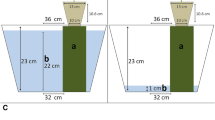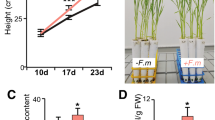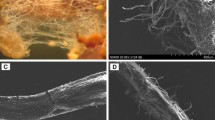Abstract
An important characteristic of arbuscular mycorrhizal (AM) symbiosis is the transfer of phosphate from AM fungi to plants. This transfer is facilitated by mycorrhiza-inducible phosphate transporter proteins. Lysophosphatidylcholine (LPC) stimulates mycorrhiza-inducible phosphate transporter gene expression. This study aims to detect the pattern of five Petunia hybrida phosphate transporter (PhPT1–5) genes associated with AM development and their response to LPC in petunia roots. Using the method of real-time reverse transcription-polymerase chain reaction (RT-PCR), we explored the transcriptional changes of PhPT1–5 genes. Our results reveal that the PhPT4 transcript level is enhanced by 8,320-fold at 40 days after inoculation in mycorrhizal roots compared with uninoculated roots. However, PhPT4 is depressed by LPC, which acts as a mycorrhiza signal in several mycorrhizal plants. Our results suggest that PhPT4 is a mycorrhiza-specific phosphate transporter and LPC is not always a universal signal in AM fungi–plant symbiosis.


Similar content being viewed by others
Abbreviations
- AM:
-
Arbuscular mycorrhiza
- AMF:
-
Arbuscular mycorrhizal fungi
- LPC:
-
Lysophosphatidylcholine
- LPE:
-
Lysophosphatidylenthanolamine
- P:
-
Phosphorus
- PC:
-
Phosphatidylcholine
- PhPT:
-
Petunia hybrida phosphate transporter
- Pi:
-
Phosphate
- PT:
-
Phosphate transporter
References
Andersen CL, Jensen JL, Orntoft TF (2004) Normalization of real-time quantitative reverse transcription-PCR data: a model-based variance estimation approach to identify genes suited for normalization, applied to bladder and colon cancer data sets. Cancer Res 64:5245–5250. doi:10.1158/0008-5472.CAN-04-0496
Bago B, Pfeffer PE, Abubaker J, Jun J, Allen JW, Brouillette J, Douds DD, Lammers PJ, Shachar-Hill Y (2003) Carbon export from arbuscular mycorrhizal roots involves the translocation of carbohydrate as well as lipid. Plant Physiol 131:1496–1507. doi:10.1104/pp.102.007765
Balestrini R, Gomez-Ariza J, Lanfranco L, Bonfante P (2007) Laser microdissection reveals that transcripts for five plant and one fungal phosphate transporter genes are contemporaneously present in arbusculated cells. Mol Plant Microbe Interact 20:1055–1062. doi:10.1094/MPMI-20-9-1055
Biermann B, Linderman RG (1981) Quantifying vesicular-arbuscular mycorrhizae — a proposed method towards standardization. New Phytol 87:63–67. doi:10.1111/j.1469-8137.1981.tb01690.x
Breuillin F, Schramm J, Hajirezaei M, Ahkami A, Favre P, Druege U, Hause B, Bucher M, Kretzschmar T, Bossolini E, Kuhlemeier C, Martinoia E, Franken P, Scholz U, Reinhardt D (2010) Phosphate systemically inhibits development of arbuscular mycorrhiza in Petunia hybrida and represses genes involved in mycorrhizal functioning. Plant J 64:1002–1017. doi:10.1111/j.1365-313X.2010.04385.x
Chapin LJ, Jones ML (2009) Ethylene regulates phosphorus remobilization and expression of a phosphate transporter (PhPT1) during petunia corolla senescence. J Exp Bot 60:2179–2190. doi:10.1093/Jxb/Erp092
Chen AQ, Hu J, Sun SB, Xu GH (2007) Conservation and divergence of both phosphate- and mycorrhiza-regulated physiological responses and expression patterns of phosphate transporters in solanaceous species. New Phytol 173:817–831. doi:10.1111/j.1469-8137.2006.01962.x
Drissner D, Kunze G, Callewaert N, Gehrig P, Tamasloukht M, Boller T, Felix G, Amrhein N, Bucher M (2007) Lyso-phosphatidylcholine is a signal in the arbuscular mycorrhizal symbiosis. Science 318:265–268. doi:10.1126/science.1146487
Finlay RD (2008) Ecological aspects of mycorrhizal symbiosis: with special emphasis on the functional diversity of interactions involving the extraradical mycelium. J Exp Bot 59:1115–1126. doi:10.1093/jxb/ern059
Genre A, Chabaud M, Timmers T, Bonfante P, Barker DG (2005) Arbuscular mycorrhizal fungi elicit a novel intracellular apparatus in Medicago truncatula root epidermal cells before infection. Plant Cell 17:3489–3499. doi:10.1105/tpc.105.035410
Gianinazzi-Pearson V, Arnould C, Oufattole M, Arango M, Gianinazzi S (2000) Differential activation of H+-ATPase genes by an arbuscular mycorrhizal fungus in root cells of transgenic tobacco. Planta 211:609–613. doi:10.1007/s004250000323
Gupta N, Gupta AK, Singh NK, Kumar A (2011) Differential expression of PBF Dof transcription factor in different tissues of three finger millet genotypes differing in seed protein content and color. Plant Mol Biol Rep 29:69–76. doi:10.1007/s11105-010-0208-y
Harrison MJ, Dewbre GR, Liu J (2002) A phosphate transporter from Medicago truncatula involved in the acquisition of phosphate released by arbuscular mycorrhizal fungi. Plant Cell 14:2413–2429. doi:10.1105/tpc.004861
Javot H, Penmetsa RV, Terzaghi N, Cook DR, Harrison MJ (2007) A Medicago truncatula phosphate transporter indispensable for the arbuscular mycorrhizal symbiosis. Proc Natl Acad Sci U S A 104:1720–1725. doi:10.1073/pnas.0608136104
Joner EJ, Jakobsen I (1995) Uptake of P-32 from labeled organic-matter by mycorrhizal and nonmycorrhizal subterranean clover (Trifolium Subterraneum L). Plant Soil 172:221–227
Karandashov V, Bucher M (2005) Symbiotic phosphate transport in arbuscular mycorrhizas. Trends Plant Sci 10:22–29. doi:10.1016/j.tplants.2004.12.003
Rivera-Vega L, Mamidala P, Koch LJ, Mason EM, Mittapalli O (2011) Evaluation of reference genes for expression studies in Ash (Fraxinus spp.). Plant Mol Biol Rep 30:242–245. doi:10.1007/s11105-011-0340-3
Ma GY, Ning GG, Zhang W, Zhan J, Lv HY, Bao MZ (2011) Overexpression of petunia SOC1-like gene FBP21 in tobacco promotes flowering without decreasing flower or fruit quantity. Plant Mol Biol Rep 29:573–581. doi:10.1007/s11105-010-0263-4
Nagy R, Drissner D, Amrhein N, Jakobsen I, Bucher M (2009) Mycorrhizal phosphate uptake pathway in tomato is phosphorus-repressible and transcriptionally regulated. New Phytol 181:950–959. doi:10.1111/j.1469-8137.2008.02721.x
Nagy R, Karandashov V, Chague W, Kalinkevich K, Tamasloukht M, Xu GH, Jakobsen I, Levy AA, Amrhein N, Bucher M (2005) The characterization of novel mycorrhiza-specific phosphate transporters from Lycopersicon esculentum and Solanum tuberosum uncovers functional redundancy in symbiotic phosphate transport in solanaceous species. Plant J 42:236–250. doi:10.1111/j.1365-313X.2005.02364.x
Olsson PA, Hansson MC, Burleigh SH (2006) Effect of P availability on temporal dynamics of carbon allocation and Glomus intraradices high-affinity P transporter gene induction in arbuscular mycorrhiza. App Environ Microbiol 72:4115–4120. doi:10.1128/Aem.02154-05
Paszkowski U, Boller T (2002) The growth defect of Irt1, a maize mutant lacking lateral roots, can be complemented by symbiotic fungi or high phosphate nutrition. Planta 214:584–590. doi:10.1007/s004250100642
Paszkowski U, Kroken S, Roux C, Briggs SP (2002) Rice phosphate transporters include an evolutionarily divergent gene specifically activated in arbuscular mycorrhizal symbiosis. Proc Natl Acad Sci U S A 99:13324–13329. doi:10.1073/pnas.202474599
Poulsen KH, Nagy R, Gao LL, Smith SE, Bucher M, Smith FA, Jakobsen I (2005) Physiological and molecular evidence for Pi uptake via the symbiotic pathway in a reduced mycorrhizal colonization mutant in tomato associated with a compatible fungus. New Phytol 168:445–454. doi:10.1111/j.1469-8137.2005.01523.x
Rausch C, Daram P, Brunner S, Jansa J, Laloi M, Leggewie G, Amrhein N, Bucher M (2001) A phosphate transporter expressed in arbuscule-containing cells in potato. Nature 414:462–466. doi:10.1038/35106601
Reddy DMRS, Schorderet M, Feller U, Reinhardt D (2007) A petunia mutant affected in intracellular accommodation and morphogenesis of arbuscular mycorrhizal fungi. Plant J 51:739–750. doi:10.1111/j.1365-313X.2007.03175.x
Reddy DMRS, Svistoonoff S, Breuillin F, Wegmueller S, Bucher M, Reinhardt D (2009) Development and function of the arbuscular mycorrhizal symbiosis in petunia. In: Gerats T, Strommer J (eds) Petunia: evolutionary, developmental and physiological genetics, 2nd edn. Springer, New York, pp 131–156
Schachtman DP, Reid RJ, Ayling SM (1998) Phosphorus uptake by plants: from soil to cell. Plant Physiol 116:447–453. doi:10.1104/pp.116.2.447
Schmittgen TD, Livak KJ (2008) Analyzing real-time PCR data by the comparative C(T) method. Nat Protoc 3:1101–1108. doi:10.1038/nprot.2008.73
Seufferheld MJ, Curzi MJ (2010) Recent discoveries on the roles of polyphosphates in plants. Plant Mol Biol Rep 28:549–559. doi:10.1007/s11105-010-0187-z
Siciliano V, Genre A, Balestrini R, Cappellazzo G, deWit PJGM, Bonfante P (2007) Transcriptome analysis of arbuscular mycorrhizal roots during development of the prepenetration apparatus. Plant Physiol 144:1455–1466. doi:10.1104/pp.107.097980
Sun F, Qi WW, Qian XY, Wang QJ, Yang MF, Dong XX, Yang JS (2011) Investigating the role of OsPDCD5, a homolog of the mammalian PDCD5, in programmed cell death by inducible expression in rice. Plant Mol Biol Rep 30:87–98. doi:10.1007/s11105-011-0307-4
Tan ZJ, Hu YL, Lin ZP (in press) Expression of NtPT5 is correlated with the degree of colonization in tobacco roots inoculated with Glomus etunicatum. Plant Mol Biol Rep. doi:10.1007/s11105-011-0402-6
Versaw WK, Chiou TJ, Harrison MJ (2002) Phosphate transporters of Medicago truncatula and arbuscular mycorrhizal fungi. Plant Soil 244:239–245. doi:10.1023/A:1020227401538
Wang S, Jiang J, Li TF, Li HY, Wang C, Wang YC, Liu GF (2011) Influence of nitrogen, phosphorus, and potassium fertilization on flowering and expression of flowering-associated genes in White Birch (Betula platyphylla Suk.). Plant Mol Biol Rep 29:794–801. doi:10.1007/s11105-010-0281-2
Wegmueller S, Svistoonoff S, Reinhardt D, Stuurman J, Amrhein N, Bucher M (2008) A transgenic dTph1 insertional mutagenesis system for forward genetics in mycorrhizal phosphate transport of petunia. Plant J 54:1115–1127. doi:10.1111/j.1365-313X.2008.03474.x
Yang YZ, Singer SD, Liu ZR (2011) Petunia AGAMOUS enhancer-derived chimeric promoters specify a carpel-, stamen-, and petal-specific expression pattern sufficient for engineering male and female sterility in tobacco. Plant Mol Biol Rep 29:162–170. doi:10.1007/s11105-010-0215-z
Zhao LM, Versaw WK, Liu JY, Harrison MJ (2003) A phosphate transporter from Medicago truncatula is expressed in the photosynthetic tissues of the plant and located in the chloroplast envelope. New Phytol 157:291–302. doi:10.1046/j.1469-8137.2003.00677.x
Zhu XC, Song FB, Liu SQ, Liu TD (2011) Effects of arbuscular mycorrhizal fungus on photosynthesis and water status of maize under high temperature stress. Plant Soil 346:189–199. doi:10.1007/s11104-011-0809-8
Acknowledgements
This work was supported by the National Transgenic Crop Research Project of China under Grants No. 2008ZX0811-005 and 2009ZX08004-003B.
Author information
Authors and Affiliations
Corresponding author
Rights and permissions
About this article
Cite this article
Tan, Z., Hu, Y. & Lin, Z. PhPT4 Is a Mycorrhizal-Phosphate Transporter Suppressed by Lysophosphatidylcholine in Petunia Roots. Plant Mol Biol Rep 30, 1480–1487 (2012). https://doi.org/10.1007/s11105-012-0467-x
Published:
Issue Date:
DOI: https://doi.org/10.1007/s11105-012-0467-x




